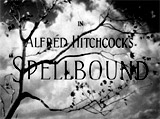
|
Spellbound (1945)
In director Alfred Hitchcock's psychological mystery-thriller
set in a psychiatric institution - it often used Freudian symbols
and analysis to add richness to the mysterious plot about identity
confusion. The noirish film was adapted by Ben Hecht and Angus MacPhail
from the 1927 novel "The House of Dr. Edwardes" written by British
authors Hilary Saint George Saunders and John Palmer (with pseudonym "Francis Beeding").
From its six Academy Awards nominations (including
Best Picture, Best Director, Best Supporting Actor (Michael Chekhov),
Best B/W Cinematography, and Best Special Effects), it won Best Original
Musical Score for Miklós Rózsa (including one of the earliest uses of the theremin -
an electronic instrument). [Note: The same year's noirish The Lost
Weekend (1945) also prominently featured the instrument.]
The MacGuffins in this melodramatic Hitchcock film
were, in essence, the memories of past traumatic events that needed
to be interpreted (through pseudo-psychology) in order to prove the
innocence of a man wrongly convicted of murder, to cure him of
physical manifestations of his mental disease, and
to assist him in finding love. The MacGuffin in the story ultimately
climaxed to reveal the unmasking of the real killer.
The mystery element of the film was played up in the film's taglines:
- Strange...Strange...Their Irresistible Love!
Dark...Dark...Their Inescapable Fears !
- Will he Kiss me or Kill me?
- The Maddest Love that ever possessed a woman
- the opening title credits concluded with a quote
from Shakespeare: "The fault...is not in our stars, but in ourselves",
and a scrolling foreword explained the process of
Freudian psychoanalysis and its virtues in unlocking the hidden
emotional secrets of the human soul that caused mental illness:
("Our story deals with psychoanalysis, the method by which modern
science treats the emotional problems of the sane. The analyst
seeks only to induce the patient to talk about his hidden problems,
to open the locked doors of his mind. Once the complexes that have
been disturbing the patient are uncovered and interpreted, the
illness and confusion disappear...and the devils of unreason are
driven from the human soul")

|
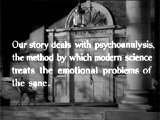
|
|
Opening Title Credits - View of Green Manors - With
a Quote and a Foreword
|
- at a Vermont mental hospital-asylum (Green Manors),
intellectual, frigid, aloof and cool-minded
psychoanalyst Dr. Constance Petersen (Ingrid Bergman), the hospital's
only female psychologist, was meeting with a very resistant young
and angry, nymphomaniacal patient named Mary Carmichael (Rhonda
Fleming); the doctor stated the whole purpose of her therapy: "When
you know why you're doing something that's bad for you and when you
first started doing it. Then you can begin curing yourself"
- after the session ended abruptly when the patient
became violent, threw a book, and was led away, a colleague named
Dr. Fleurot (John Emery) evaluated Dr. Petersen's cold demeanor
and "brilliant but lifeless" style as a detriment to her success:
("Your lack of human and emotional experience is bad for you as
a doctor and fatal for you as a woman"); she rebuffed his excuses
to make amorous advances at her, including a coldly-received kiss
- meanwhile, new handsome psychiatrist Dr.
Anthony Edwardes (Gregory Peck) was arriving to replace
the outgoing director or head of the institution, Dr. Murchison
(Leo G. Carroll), who had been involuntarily retired after 20 years
of service by the board of directors; he had "crumbled" from mental
exhaustion after a recent trip, due to being overworked; it was
also the final few days of Murchison's six-month mentoring of Dr.
Petersen
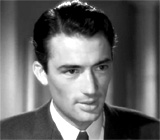
|
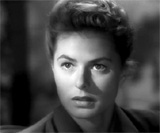
|
|
Dr. Petersen's Immediate Attraction to Dr. Edwardes
|
- Dr. Petersen was immediately attracted to the
new young director of Green Manors, Dr. Edwardes, a
reknowned expert on guilt complexes; Dr. Petersen succinctly described
his own theory to him: "People often feel guilty over something they
never did. It usually goes back to their childhood. The child often
wishes something terrible would happen to someone, and if something
does happen to that person, the child believes he's caused it. Then
he grows up with a guilt complex over a sin that was only a child's
bad dream" - her words neatly foreshadowed the problems that would
surface for Dr. Edwardes
|
Images Causing Traumatic Reactions - Related to
Dr. Edwardes' (or JB's) Past
|
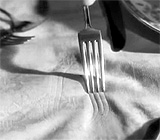
Fork Tracks on a Tablecloth at the Institution
|
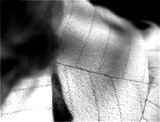
The Dark Parallel Lines on Dr. Petersen's Robe
|
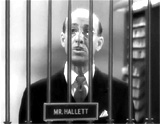
The Vertical Bars at the Penn Train Station Ticket Office
|

Parallel Train Tracks On the Train Trip to Rochester, NY
|
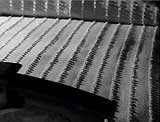
Lines on a Bedspread at Dr. Brulov's Guest Room
|
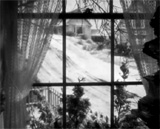
Parallel Sledding Tracks in Snow Outside Dr. Brulov's Window
|
- director Hitchcock featured set-pieces to depict
the crazed and phobic mental state of Edwardes - represented by
MacGuffins that needed to be interpreted or solved; Dr. Edwardes
frequently saw disturbing images shortly after his arrival; the first
image to cause an anxiety attack was parallel fork lines
drawn by Constance on a tablecloth; why
did the lines or patterns haunt and agitate the sanity of the young
Dr. Anthony Edwardes? -- was it due to childhood trauma, or a forgotten
murder from the past?
- during an afternoon picnic, Dr. Edwardes
and Dr. Petersen's love affair deepened as they ascended up a hillside,
and she returned to the institution - with a distracted, slightly
disheveled look and tossled hair; that evening, after being unable
to sleep that evening, she ventured to the institution's
library, where she located Dr. Edwardes' personally-autographed book (Labyrinth
of the Guilt Complex)
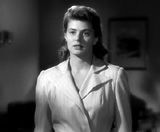
|
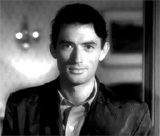
|
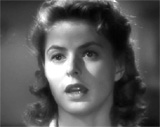
|
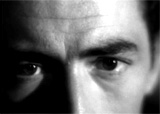
|
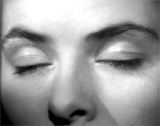
|
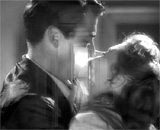
|
|
The Growing Strength of a Love Affair Between Dr.
Edwardes and Dr. Petersen
|
- she entered Dr. Edwardes' living quarters,
claiming she wanted to discuss his book with him, but then was embarrassed
to admit "subterfuge...like a distracted child" that it was only
an excuse to see him again; he admitted that he had fallen
for her that afternoon: ("It was like lightning striking. It strikes
rarely"); he approached her, causing her to shut her eyes as she submitted
to him: ("I don't understand how it happened"); a double-exposed
image of multiple doors opening down a hallway appeared as they
kissed and embraced
- but then as they closely hugged each other, parallel
stripes on her white robe (all lines on a white background) caused
him extreme anxiety and he briefly became dizzy and panicked (theremin
sounds accentuated his acute reaction) at the sight of the dark lines
- she realized that he had some unusual and mysterious
deep-seated problem; he was called away to conduct an
emergency surgery in a subterranean operating room
on a violent patient who attempted to slit his own throat;
Dr. Edwardes reacted with another panic attack, disorientation
and physical collapse after complaining about the dark corridor without lights
- while Dr. Petersen cared for him that evening as
he slept, she realized that the signature on a note slipped to
her earlier by him was markedly different from his autograph in
his book; she suspected he was a fraud; when he wakened, she confronted
him directly: "Who are you?"
- as a result of Dr. Petersen's probing, Edwardes
admitted that he was an imposter, had no memory, and also expressed
fears that he may have killed the real Dr. Edwardes, and then taken
his place at Green Manors: ("I remember now. Edwardes is dead.
I killed him and took his place. I'm someone else, I don't know
who. I killed him. Edwardes")
- Dr. Petersen became even more concerned about Edwardes'
mental state, involving delusions and paranoia, neurosis, and memory
loss (amnesia); he tried to explain the reason for his amnesia:
("A trick of the mind for remaining sane. You remain sane by forgetting
something too horrible to remember"); when he assumed he had committed
murder, she responded: "That's a delusion you have acquired out
of illness"
- he explained two incidents that caused him to realize
he was being confused with Dr. Edwardes; the previous day, his
office assistant Norma Cramer had called and didn't recognize
his voice, and another connection to his past reality was the discovery
of his monogrammed cigarette case with the
initials "J.B."; although she was
still falling in love with him, Dr. Petersen began to rationally
suspect that Dr. Edwardes was delusional and homicidal, and might
have murdered the real Dr. Edwardes (Edward Fielding)
- after his confession, Edwardes fled that night
from the institution to the Empire State Hotel, leaving behind
a love note for Constance under her door about his whereabouts; the
next morning, the police arrived after being alerted to the possibility
that 'Edwardes' was a fraud - due to accusations by the office
assistant Norma Cramer and her copy of Edwardes' actual photograph
- an important revelation - important later - was
that Murchison claimed, after looking at the photo, that he had
never met the real Edwardes; he also accused the "imposter" of killing
Edwardes: "He killed Dr. Edwardes and took his place in order to
conceal his crime by pretending the victim was still alive"
- Dr. Petersen set out in pursuit after him, and located 'Edwardes' in
his NYC hotel where he had taken the name 'John Brown'; once she
found him, she stated her intentions: "Take care of you, cure you,
and remain with you till that happens"; he repeated
his fears that he was being regarded as a criminal for assuming Edwardes'
identity as an imposter; she added: "I'm here
as your doctor only. It has nothing to do with love" - but they
kissed passionately, betraying her thought
- she psychoanalyzed him in
the hotel room, hoping "if we can unlock one tiny memory,
it will give us a key to the others"; they determined that
he had medical knowledge and his real occupation was as a medical
physician; he also noted one thing he was logically certain of
- that he had been a patient (suffering from war-related "nerve
shock") of the real Dr. Edwardes at a Cumberland Mountains resort
and was with him on the day that he disappeared (or died?) (during
a skiing incident); he also imaginatively feared that he might
have hidden the body; she surmised that he may have been in an accident
- she noticed third-degree burns (and recent skin-grafts)
on his left hand, but he couldn't recall their origin; their conversation
was interrupted by the delivery of the recent newspaper with an
illustrated article about Dr. Constance Petersen "Believed
Aiding Madman Wanted in Edwardes Mystery"; when recognized
by the bellboy, they were compelled to leave the hotel immediately
(a familiar 'innocent man on the run' plot); as they fled together
to the Pennsylvania Station, he fainted when pressured to remember
at the ticket counter (with vertical bars) where he might have
been going when he left the Cumberlands and bought tickets with
Dr. Edwardes; she changed their initial ticket purchase destination
from Rome, GA, and suggested a diversion - to instead go to Grand
Central Station and board a train to visit her previous teacher,
mentor and psychoanalyst Dr. Alexander "Alex" Brulov
(Michael Chekhov) who lived in Rochester, NY, to diagnose JB's
case via dream analysis
- on the train, he recalled that he had received
the burns while flying during a WWII medical transport mission
in Italy (over Rome - the reason for his recollection about Rome),
when he had to bail out and parachute to safety - subsequently
suffering from "nerve shock" (today's PTSD)
- once they arrived at Dr. Brulov's home, Constance
introduced JB as her newly-wed husband "John Brown" and
they were on their honeymoon; he congratulated her but also warned: "Women
make the best psychoanalysts till they fall in love. After
that, they make the best patients"; as they retired to the
upstairs guest room that evening (to sleep in separate beds), they
kissed each other; JB again suffered an anxiety attack over the parallel lines
or patterns on the bedspread; during
the night, he also panicked in the all-white bathroom as he attempted
to shave; in a trance-like dazed state, the disturbed JB descended
the stairs as the camera focused on the straight-edged razor carried
in his right hand as he approached the old doctor
seated downstairs; Dr. Brulov shared a late-night milk and crackers
snack break with JB
- the next day, the suspicious and wily Dr. Brulov
told Dr. Petersen that he had instinctively realized
that there were signs that JB might be a dangerous lunatic murderer
(he had taken precautions the previous evening by putting bromide in
JB's milk as a sedative); he was threatening to call
the police, but Dr. Petersen dissuaded him by trying to convince him
that she couldn't love a bad man who had committed murder; Dr. Brulov
questioned Constance's "school-girl" innocence and cautioned her that
she might be in love with a schizophrenic: "We both know that
the mind of a woman in love is operating on the lowest level of the
intellect....You are 20 times crazier than him. 'She couldn't love him if he
was no good.' This is baby talk. Nothing else"; she convinced
him to give her a few days so that they could treat and cure him as
doctors, and prove his innocence
- once JB revived the next morning, Dr. Brulov began
to interpret the dream he had the night before, explaining: "The
secrets of who you are and what has made you run away from yourself,
all these secrets are buried in your brain...They tell you what
you are trying to hide. But they tell it to you all mixed up, like
pieces of a puzzle that don't fit. The problem of the analyst is
to examine this puzzle and put the pieces together in the right
place. And find out what the devil you are trying to say to yourself"
|
The Dream Analysis Session with Dr. Brulov and Dr.
Petersen
|
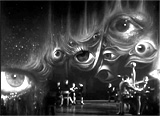
Gambling House With Eyes Painted on Curtains
|
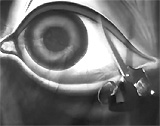
Man With Scissors Cutting Drapes in Half
|
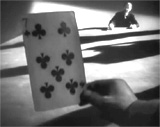
Dealing at Blackjack, and Losing to a Bearded Man
|
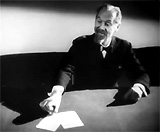
The Bearded Man's Cards Were Blank
|
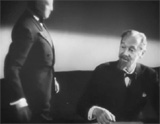
Faceless Proprietor Accused the Man of Cheating and Threatened Him
|
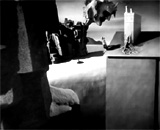
Sloping Rooftop Where Bearded Man Tumbled Down
|
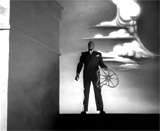
Proprietor on Sloping Rooftop Behind Chimney With Misshapen Wheel in His Hand
|
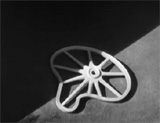
The Wheel Was Dropped On the Rooftop and Partially Slid Down
|
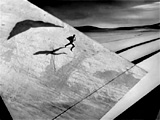
The Dreamer Was Pursued Downhill by Large Flapping
Wings
|
- a pivotal, brilliant nightmarish dream-remembrance
sequence, conceived by surrealist artist Salvador Dali, depicted
JB's recent puzzling dream due to his trauma:
- there was a room in a gambling house or casino
(with disembodied eyes painted on the curtains)
- a man with a large pair of scissors was cutting
the drapes in half
- a partially-clad girl entered and kissed everyone,
starting at the dreamer's table first
- in the room, as the dreamer was dealing cards
during a game of blackjack (or 21) at a long table with an
elderly bearded man, he turned up a seven of clubs;
the elderly man declared that he had won and hit 21; but when
he turned his cards over, they were blank
- an angry, faceless, masked proprietor entered
the scene and accused the elderly gent of cheating
- the old bearded man was leaning too far over
the sloping roof of a high building, and slowly fell head-over-heels
off the roof
- the proprietor appeared again on the sloping
rooftop, hiding behind a tall chimney with a small misshapen
wheel in his hand; he dropped the wheel on the rooftop
- after a dissolve, the dreamer found himself
racing on foot toward the bottom of a steeply sloped hill,
pursued by a giant pair of shadowy, flapping wings
- at the conclusion of the dream sequence, JB was
traumatized when looking out Dr. Brulov's window, viewing a slope
of white snow with dark sledding tracks; Dr. Petersen interpreted
JB's phobia: "It was the snow. That's the white he's afraid of.
Snow and those (sledding) tracks"; the
parallel lines represented his partial, corrupted memories of a
traumatic ski accident at a ski resort that he had witnessed when
he was skiing there with Dr. Edwardes (Dr.
Petersen: "Ski tracks in the snow. That's what those dark lines
symbolize for him. His horror of them means, of course, that they
are immediately connected with the cause of his amnesia"); Dr.
Brulov added: "Yes. A murder on skis"
- Dr. Petersen and Dr. Brulov
began to analyze the dream - (1) the sloping roof was a mountain
ski area, (2) the older man in the dream
represented the real Dr. Edwardes who had died on the
slopes while skiing, (3) he had been chased downhill by a shadow
over a precipice; they interpreted that the
resort's location was in a valley (with sloped hills), and that the
wings recalled Gabriel (the winged angel) - thus, Gabriel Valley
- to re-enact the troubling incident, Dr. Petersen
and 'John Brown' (JB) took the train to the Gabriel
Lake Lodge ski resort; Dr. Petersen was convinced that the guilt-ridden
JB must unlock a key traumatic element from his childhood in order
to learn more about Dr. Edwardes' death: ("We'll find out what
it was in your childhood that's haunted you all your life. We'll
also find out what happened to Dr. Edwardes")
- while skiing with her down the steep slope, in
a blood-chilling sequence, he vividly remembered his young brother's
accidental and tragic death by impalement on a spiked fence. JB
had inadvertently killed his brother by sliding down a sloping
concrete incline and pushing the boy off the ledge onto the protruding
spikes; this event was the initial reason why JB had
developed dissociative amnesia and a guilt complex, often with
images of downward falling
- at the same time as he realized it was an innocent
accident: ("I didn't kill my brother, it was an accident"), his
recovered memory revived him and inspired him to save Constance
from skiing down and off the edge of the same steep slope on which
his analyst, the real Dr. Edwardes, in JB's presence earlier, had
accidentally skied off the steep precipice and fallen to his death,
just 50 feet ahead of him; Dr. Petersen was relieved: "You
took on the role of Dr. Edwardes to prove to yourself he wasn't
dead, so therefore, you had not killed him"; with
his memory jarred, he remembered his real name - Dr. John Ballantyne
(or "JB")
- they were jarred when accosted by the authorities,
who questioned them about the details of Dr. Edwardes' death; earlier
when Ballantyne had told them where the body could be found, the
police recovered Edwardes' actual corpse; to their shock, they also discovered a bullet
wound in the body's back; they now suspected
John Ballantyne of murder; because Ballantyne had confusedly claimed
he might have killed Edwardes due to his mental illness, he was convicted
of the murder and sent to prison; Dr. Petersen vowed to free him
- after returning to her position at the hospital
in Vermont where Dr. Murchison was still director, Dr. Petersen
realized his treachery after he mentioned: "I knew Edwardes
only slightly. I never really liked him. But he was a good man,
in a way, I suppose." He contradicted his earlier statement
that they had never met. She immediately knew that if he had known
Edwardes, he shouldn't have mistaken the imposter Ballantyne for
Edwardes; his words echoed with increasing intensity in her
mind when she realized that Murchison was lying
- she ascended the stairs to Murchison's office to
confront him, but first, she suggested that he analyze and interpret
her patient John Ballantyne's dream notes:
- the scissors-cutting and the scantily-clad,
kissing girl represented inmates at Green Manors (symbolized
as a gambling house using blank cards)
- the eyes painted on the curtains in the gambling
house represented the guards at Green Manors
- the bearded man playing blackjack card game
(aka 21) was authority figure Dr. Edwardes
- the mention of "21" (and the 7 of 'clubs') referred
to both the exclusive 21 Club in NYC and Green Manors
- the angry proprietor of the club (or institution)
who made accusations of cheating against Dr. Edwardes was actually
Dr. Murchison, who ordered him out: ("This is my place, I'm
going to fix you")
- the high sloping roof was the ski slope where
the patient saw Dr. Edwardes plunge over the edge to his death,
while the angry proprietor who was hiding behind the chimney
laughed, holding a misshapen wheel that dropped from his hand
- the wheel represented the revolver
(the weapon used to kill Dr. Edwardes by shooting him in the
back from behind a tree just as he was skiing down the slope
at Gabriel Valley near the edge of the cliff)
- in Ballantyne's full view, he had seen a bullet delivered from
Murchison's gun, but had repressed the real cause of death [Note:
Murchison had used Ballantyne's disabilities to frame him]
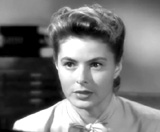
Dr. Petersen Describing Ballantyne's Incriminating Dream to Dr. Murchison in
His Office
|
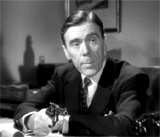
Dr. Murchison Pulling Out His Revolver
|

Dr. Murchison Pointing His Gun and Threatening Dr.
Petersen As She Calmly Exited From His Office
|
- Murchison pulled his murder weapon from his desk,
and held it toward her, while threatening
her because of her knowledge of his crime; Dr.
Petersen tricked Murchison into admitting that in a "state of panic,"
he had confronted Dr. Edwardes having lunch at the 21 Club in NYC
with Ballantyne, where he threatened to kill him to prevent him from
taking over his job at Green Manors; he then followed the doctor
and Ballantyne to the ski slope and shot Dr. Edwardes from behind;
witnessing the death, Ballantyne had then subconsciously assumed
the guilt of the murder and substituted himself for Edwardes at the
sanitarium; it was very obvious that the murderer of Dr. Edwardes
was the jealous and treacherous Dr. Murchison, who had framed imposter-Ballantyne
for the murder of Edwardes
- even before Dr. Petersen had stated any factual
evidence that could convict Dr. Murchison, he attempted to discount
Dr. Petersen's accusations: "A love-smitten analyst playing
a dream detective"; but she countered him, saying there would be
numerous witnesses to his actions: ("There
will be no dreams necessary for this case")
- he appeared unworried about the consequences of
murdering her: "The punishment for two murders is the same as for one." She
struck back: "You're not going to commit a second murder, Dr.
Murchison." He made it clear that he had deadly intentions: "I hadn't planned
to, but you're here. You're not leaving"
- using psychoanalysis, Dr. Petersen cautioned him
to not murder her; she asserted that his previous crimes might
result in a life sentence or a prison term due to extenuating circumstances,
but that he would undoubtedly get the death penalty (electric chair)
for her cold-blooded, pre-meditated murder: "A man with your
intelligence does not commit a stupid murder. You're thinking you
were not mentally responsible for that other crime in the snow.
They'll find extenuating circumstances in the state of your health.
They'll not execute you for the death of Dr. Edwardes. You can
still live, read, write, research, even if you are put away. You're
thinking that now, Dr. Murchison"
- the conniving murderer pointed
his gun at her back and tracked her (from his subjective POV) as
she stood up and calmly moved toward the exit door, after revealing
his treachery. She continued: "If you shoot
now, it is cold, deliberate murder. You will be tried as a sane
murderer, convicted as a sane man, and killed in the electric chair
for your crime." She announced that she was leaving the room
to phone the police
- Dr. Murchison memorably committed suicide in the
conclusion by slowly turning the gun on himself (toward the camera)
and pulling the trigger after she left his office and shut the
door. It was a shocking first person point-of-view shot, with a
fraction-of-a second splash of red color (in the B/W film)
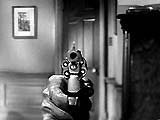
|

|
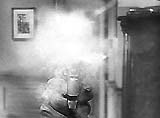
|
|
Dr. Murchison's Suicide - With a Split-Second Splash
of Red
|
- in the film's epilogue, JB and Constance had been
married and were preparing to board a train at Grand Central Station,
and saying goodbye to Dr. Brulov; they kissed each other after
handing their tickets to the same wide-eyed conductor who recognized
them from their previous trip to Rochester, NY
|

Dr. Constance Petersen (Ingrid Bergman)
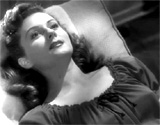
On Dr. Petersen's Therapy Couch: Patient Mary Carmichael (Rhonda Fleming)

Dr. Fleurot's Rebuffed Romantic Advances Toward Cold Dr.
Petersen

Outgoing Director Dr. Murchison (Leo G. Carroll) - Mentor to Dr. Petersen
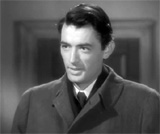
Asylum's New Replacement Director Dr. Anthony Edwardes (Gregory Peck)
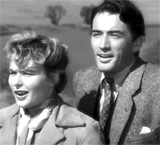
An Afternoon Hillside Picnic - A Growing Love Affair
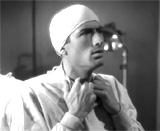
Dr. Edwardes' Panic Attack During an Emergency Surgery
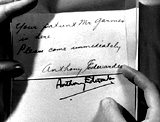
Comparison of Two 'Edwardes' Signatures - Was He a Fraud?
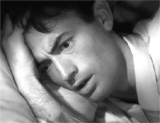
'Edwardes' Disturbed Confession: "Edwardes is dead.
I killed him and took his place"
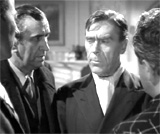
Dr. Murchison's Spurious Claim that He Had Never Met Dr. Edwardes

NYC's Empire State Hotel
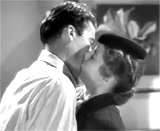
Dr. Petersen Pursuit of "John Brown" To Be His Doctor
- "It
has nothing to do with love"
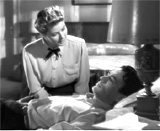
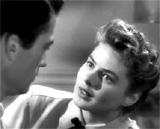
Dr. Petersen's Psychoanalysis of "John Brown"
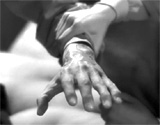
What was the Reason for Burn Scars on "John Brown's" Left
Hand?
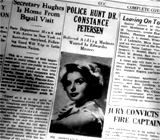
Newspaper Headlines: "POLICE HUNT DR. CONSTANCE PETERSEN"
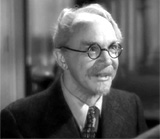
Dr. Alexander "Alex" Brulov (Michael Chekhov)
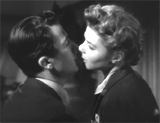
On Their "Honeymoon" - Hiding Out with Dr. Brulov
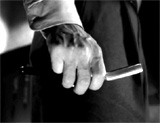
JB with a Straight-Edged Razor in His Hand as He Approached Dr.
Brulov
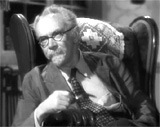
Dr. Brulov Cautioning Dr. Petersen about Loving a Possible Lunatic
Schizophrenic ("This is baby talk")
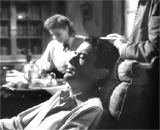
JB's Free- Association
Surrealistic
Dream
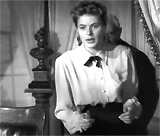
Dr. Petersen's Sudden Revelation: ("Ski tracks in the snow.
That's what those dark lines symbolize for him")
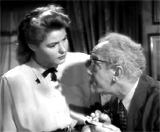
Dr. Petersen and Dr. Brulov Interpreting the Dream Together
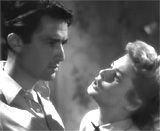
"We have to go to Gabriel Valley"
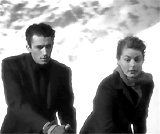
Skiing Together
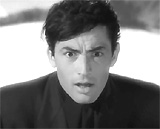
Remembering Traumatic Event of Childhood On Ski Slope

Ballantyne's Memory of His Young Brother's Tragic
Impalement Death ("I killed my brother")
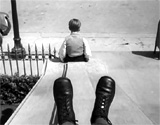
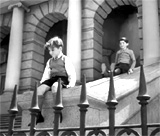
Childhood Trauma

Saving Both of Them From Skiing Off a Precipice
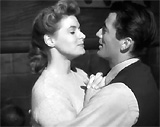
The Couple: Relieved to Have Figured Out The Reason For His Guilt
Complex
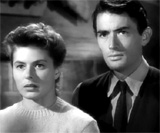
Stunned! - JB Charged With Murdering The Real Dr. Edwardes (Shooting
Him in the Back)
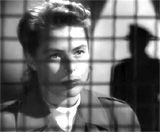
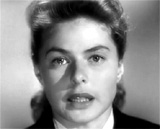
Dr. Petersen Vowing to Free JB From Prison For Murder Charges
|



































